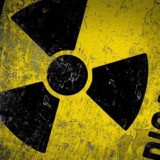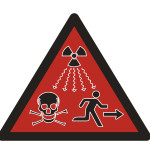Twenty-five years ago, after consensus on the reality and impacts of manmade climate change led to the formation of the Inter-governmental Panel on Climate Change, western governments had two choices. They could either stop subsidising fossil fuel industries and invest the savings in promoting energy efficiency and renewable energy (e.g. putting solar panels on all public buildings to bring the price down for homeowners) or they could make long, lingering love to Fido.
They chose the latter and now, a quarter of a century later, we are being told by these same governments that our best hope of averting the worst consequences of climate change is to embrace nuclear power.
“Look,” they say, “no carbon dioxide emissions! Isn’t that great?” Well, no, it isn’t. It’s a bit like being told your only two choices are being beaten to a pulp tomorrow or being beaten to a pulp in ten years.
Assume for a moment that it is possible to guarantee there will never be another Chernobyl or Fukushima (and that’s a very large and problematic assumption), you can never produce nuclear energy without producing nuclear waste. This waste – leftover plutonium and uranium, as well as various isotopes – can remain lethally radioactive for an unimaginably long time.
The speed with which radioactivity decreases is measured by its half-life (the time it takes for half the radioactivity to decay). Picking just a few of the isotopes in nuclear waste, the half-life of Strontium-90 is 28 years and the half-life of Plutonium-239 is 24,000 years, while the half-life for Caesium-135 is 2.3 million years and for Iondine-129 is 15.7 million years.
Half a century after realizing quite how dangerous nuclear waste is, there is still no safe way to dispose of it – nor is there ever likely to be.
That’s not to say there haven’t been some ill-conceived suggestions, including dumping it in the oceans and blasting it into space. (In the aftermath of the Challenger space shuttle disaster, my father-in-law – a renowned nuclear physicist – commented that the tragedy should at least serve as a warning against the latter proposal. Unfortunately, he was wrong. Apparently it might be a good idea to put nuclear waste in orbit around Venus– in case we ever want to retrieve it. I kid you not.)
The waste problem is very bad news for the nuclear energy industry and, like many other industries in the past, it has decided the best thing to do with bad news is to bury it.
As Anna Tilman reports in the current issue of Watershed Sentinel, proponents of nuclear power (both industry and government) have decided that Deep Geological Repositories (DGRs) are the “final solution” to the problem of nuclear waste.
The theory behind DGRs is that nuclear waste can be safely stored “forever” deep underground in geologically stable areas.
The reality, as Tilman points out, is that “nothing is immutable, not even rocks. Containers will eventually corrode. Cracks and fissures will develop. Groundwater will seep in. Water and gas contaminated with radionuclides will penetrate the barriers. Chemical and microbial processes and interactions will occur, with unpredictable results. Climate change, glaciations and earthquakes could severely destabilise the repository.”
Ignoring Geology 101, governments (including Canada’s) have been pushing hard for many years to establish DGRs. So far, none have succeeded, although one is currently under construction in Finland. (A documentary about this project, Into Eternity, eloquently makes the case for why this is a bad idea. It should be required viewing for all government leaders.)
Finding an “informed and willing host community” is, not surprisingly, a challenge for Canada’s Nuclear Waste Management Organization (a federal agency established in 2002 and run by the nuclear industry), despite the fundamentally flawed consultation process Tilman describes in her article.
The International Atomic Energy Agency (IAEA) estimates that the volume of radioactive waste on the planet already exceeds 345,000 tonnes – 50,000 tonnes in Canada alone.
We’ve created this disaster and, of course, we have to deal with it. (Personally, I would establish secure, monitored, above ground storage facilities paid for by and located in the backyards of every nuclear power industry executive and government supporter.)
What we absolutely, positively do not have to do is add to the problem.
Every year, each of the more than 400 nuclear reactors currently operating in 31 countries adds an average of 30 tonnes to the total volume of nuclear waste.
This is the sign the IAEA thinks will protect thousands of future generations from the dangers of nuclear waste:
This is the sign I think will best protect them:
Read Anna Tilman’s article “Nuclear Fuel Waste in Canada” here.




Thursday, 21 February 2013 02:10 posted by Jaro Franta
How can any “Common Sense Canadan” spout such nonsense?
Since we’re talking Canadian here, how about a look at how Nature has shown us to store radioactive material for very long periods?
“The most remarkable natural analog [for a nuclear waste repository] is the Cigar Lake uranium deposit recently discovered in northern Saskatchewan, Canada. Representing about 11% of the world’s known uranium reserves, Cigar Lake is one of the richest and largest uranium deposits known to mankind. Its significance to the science of waste disposal is due to two factors: (1) it exists in about 98% abundance as uranium dioxide, UO2, which is the same form as reactor fuel; and (2) the high-grade ore is protected from groundwater by a covering “dome” of clay (see diagram), which is conceptually similar to Canada’s disposal plan. Additionally, the high grade of the ore permits the interaction between the uranium and the host material to be analysed in a highly sensitive and unique manner.
Despite emplacement in highly permeable sandstone host rock, the Cigar Lake ore deposit has survived roughly 1.3 billion years of geologic history, chiefly because of its natural clay buffer. The clay immobilizes the uranium by reducing both the penetration of groundwater into the deposit, and the diffusion of uranium atoms out of the deposit. Remarkably, the deposit has remained intact through several mountain-building episodes (the Rocky Mountains, the Appalachians), the trauma of continental drift, multiple ice ages, and significant uplift caused by the erosion of over 2.5 km of overlying sedimentary rock. In fact, it is so stabilized in its position, currently 430 metres below the surface, that no chemical or radioactive signature can be detected on the ground above it. Since the Canadian waste disposal concept calls for a much less permeable host rock (batholithic granite), and a superior clay buffer (bentonite clay, rather than Cigar Lake’s illite clay), the barriers to water movement and radionuclide migration proposed in the Canadian plan are verified by Cigar Lake.”
http://www.nuclearfaq.ca/cnf_sectionE.htm#v2
Wednesday, 20 February 2013 23:34 posted by Eric L. Hanson
Sr-90 has a half-life of 28 years I-129 has a half-life of 15.7 million years. Isotopes with a short half life, like Sr-90, are dangerous for a short period of time. Give it 5 half lives, only 140 years, and it is almost gone. There will be only 3.125% of the original Sr-90.
A long half life, like 15.7 million years, means that the substance is just barely radioactive, and not even close to being dangerously radioactive. I point out that a stable, non-radioactive substance, has an infinitely long half life. So an extremely long half life means that it is very close to being not radioactive at all.
That’s the way it works. A isotope is either highly radioactive (and therefore dangerous) for a short period of time or lowly radioactive and therefore not dangerous at all. It can’t be both.
All of which means that the author’s next statements about DGRs (Deep Geological Repositories) are also wrong. If you bury spent nuclear fuel for about 300 years, it is no more radioactive than the original uranium ore.
50,000 tonnes, with a density of 9.5, means that it would all fit into a cube less than 20m a side. The waste has a small volume and it is therefore a small problem.
Eric
Wednesday, 20 February 2013 23:32 posted by Karl Johanson
@ Susan: The media floods us with stories about Fukushima. What much of the media ignores is the UN estimate that smoke from fossil fuels and biomass energy kills around 2.5 million people per year. That’s more than the Fukushima killed, every hour of every day, and more than 60 million since Chernobyl.
Wednesday, 20 February 2013 22:49 posted by Jim Conca
Your ignorance of nuclear waste is quite extreme. Why haven’t you taken the time to research the WIPP site? The only operating deep geologic repository we need for everything. It’s been operating since 1999 and has disposed of more waste than was ever destined for Yucca Mt. As a geologist and a Greenpeace lifer who has worked on every HLW program in the world, it’s the best place for any nuclear waste. It should even take Canada’s if the fear-mongering would stop for a moment. In this massive Permian salt deposit, it takes almost a billion years for water to move a cm. as a journalist, you need to do due diligence before making stupid statements.
Dr. James Conca
Wednesday, 20 February 2013 22:19 posted by Karl Johanson
Natural nuclear reactors in Gabon Africa showed us that a permanent repository for spent nuclear fuel isn’t so hard a thing to manage. At least 9 natural breeder reactors went critical at Oklo, in Gabon about 1.8 billion years ago, for around half a million years. Thousands of pound of Plutonium was produced and it barely migrated through the rock it happened to form in, as evidenced by radio-decay products. This rock was fractured, in a geologically unstable area. The Plutonium was uncontained, unvitrified and it wasn’t surrounded by bentonite clay (as is planned for man made spent fuel repositories). As well, boiling water flowed over this Plutonium for around half a million years (more than 20 half lives of Plutonium 239). So putting spent nuclear fuel in multilined containers, & surrounding it with bentonite clay, in ground rock with substantially lower ground water motion than at Gabon, is not only more than acceptable, it’s serious over kill.
Regardless, the longer the spent fuel is kept out of permanent repositories, the greater the chances are of the spent fuel being reused.
Thursday, 07 February 2013 20:26 posted by Susan hodges
A message that so much needs to be heard it is hard to put into words. Mainstream media has contributed to nuclear proliferation by refusing to mention any part of the industry at all, while we all are bombarded by the latest pop star or sport star’s antics or crime down the st. With absolutely no info via regular mass news sources re the fallout ok Fuukshima, i have learned an awful lot. It all still shocks me. Thank you for a brilliant article. People need to learn about this.